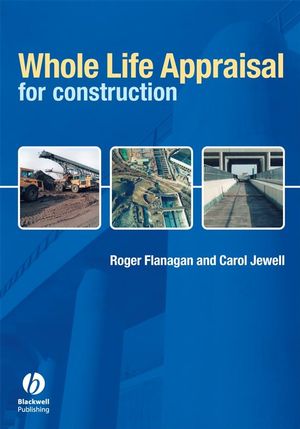Whole Life Appraisal for ConstructionISBN: 978-0-632-05046-8
Paperback
192 pages
March 2005, Wiley-Blackwell
 |
||||||
Acknowledgements vii
Preface viii
1 Whole life appraisal – an introduction 1
1.1 Objective 1
1.2 What is whole life appraisal (WLA)? 1
1.3 Why bother with whole life appraisal? 2
1.4 Is whole life appraisal different to whole life costing (WLC)? 2
1.5 Who uses WLA and WLC? 2
1.6 When should WLA be undertaken? 3
1.7 What is the link between best value and best price? 3
1.8 Nobody can accurately forecast the future, so how reliable are the results of a whole life appraisal exercise? 4
1.9 How can money spent at different times over the life of a facility be incorporated into WLA? 4
1.10 What discount rate should be used? 4
1.11 How is inflation taken into account in the calculations 5
1.12 Why isn’t WLA used more widely? 5
1.13 So why bother now with WLA? 6
1.14 Has the computer made a difference to the calculation of WLA? 7
1.15 What has happened overseas? 7
1.16 The whole process seems to be surrounded by jargon; how can WLA be made simpler to understand? 8
1.17 Where does sustainability fit with WLA? 8
1.18 Have the Construction Design and Management Regulations
(CDM) 1994 changed the way
whole life issues are considered? 8
1.19 How does WLA fit with facilities/asset management 9
1.20 What is service life planning? 9
1.21 Integrated Logistic Support (ILS) is a term used by the defence and aerospace industries; is WLA used in ILS? 9
1.22 What is the difference between running costs and operating and maintenance costs? 10
1.23 How does the residual value work? 10
1.24 Should disruption costs be included in the WLA? 10
2 Whole life appraisal: preliminary concepts 11
2.1 Introduction 11
2.2 Whole life appraisal and construction 15
2.3 Performance of systems, components and materials 17
2.4 Design with whole life appraisal 18
2.5 Whole life appraisal for new and old facilities 20
3 An overview of whole life appraisal 23
3.1 The importance of whole life appraisal 23
3.2 The adoption of whole life appraisal 23
3.3 The balance between fixed and variable costs 26
3.4 Different client motivations for the use of whole life appraisal 30
3.5 The implementation of a whole life appraisal system 34
3.6 The output of whole life appraisal 40
3.7 Some unresolved problems 44
4 Whole life appraisal at the planning and design stage 45
4.1 Introduction 45
4.2 The components of whole life appraisal 48
4.3 Whole life costing and cost management 54
4.4 Appendix to Chapter 4 58
5 Discounting and the time value of money 65
5.1 Introduction 65
5.2 Discounting 67
5.3 Choosing between alternative options 78
5.4 Internal rate of return (IRR) 83
5.5 Inflation 84
5.6 Risk, uncertainty and sensitivity analysis 89
5.7 Summary 91
5.8 Appendix A to Chapter 5 92
5.9 Appendix B to Chapter 5 93
6 Data sources for whole life appraisal 95
6.1 The importance of improving data accuracy 95
6.2 Shared data 96
6.3 Computer aided design (CAD) 97
6.4 Basic data sources 97
6.5 Running costs of different types of buildings 101
6.6 Data on durability and life expectancy of materials 108
7 Operations and maintenance 115
7.1 Maintenance 115
7.2 Energy in buildings 121
8 A practical approach to whole life appraisal for construction 129
8.1 Introduction 129
8.2 Initial problems 129
8.3 Using the weighted evaluation technique as a decision-making tool 130
8.4 A whole life approach involves a feedback system 134
8.5 Whole life analysis 136
8.6 Whole life planning 137
8.7 The relationship between whole life analysis and whole life planning 138
8.8 Cost relationships 140
8.9 The sequence of whole life analysis, whole life planning and whole life management 142
8.10 Documentation format for whole life planning 144
8.11 Costs and benefits 147
9 Taxation and whole life appraisal 149
9.1 The implications of taxation and grants for whole life cost 149
9.2 Capital allowances for facilities 150
9.3 Capital allowances for machinery, plant and equipment 153
9.4 Capital savings allowances and energy savings 154
10 Integrated logistic support (ILS) 159
10.1 What is ILS? 159
10.2 Where did ILS come from? 159
10.3 What is the difference between ILS and whole life appraisal? 160
10.4 ILS and construction 160
10.5 Why use ILS? 161
10.6 The concepts of ILS 162
10.7 The main steps of ILS 162
10.8 The benefits of ILS 163
10.9 An example of ILS 163
10.10 Summary for ILS 164
11 Summary and conclusions 165
Glossary of terms used in whole life appraisal 169
References and bibliography 175
Index 181



